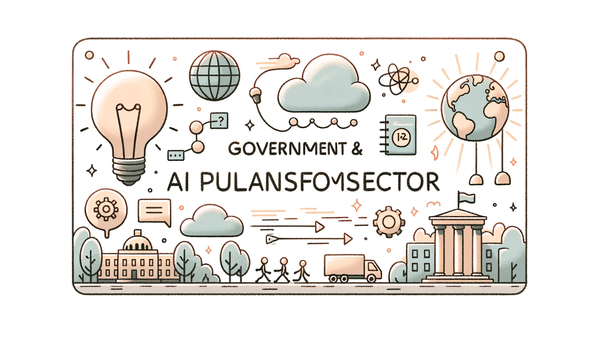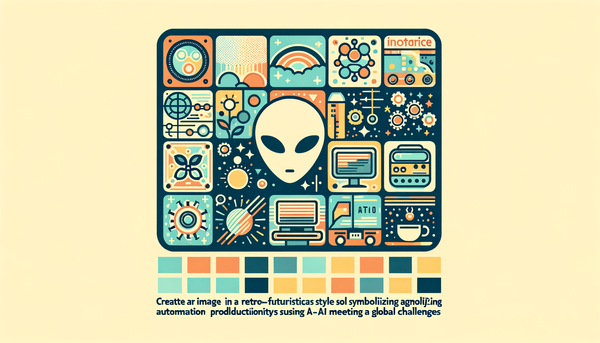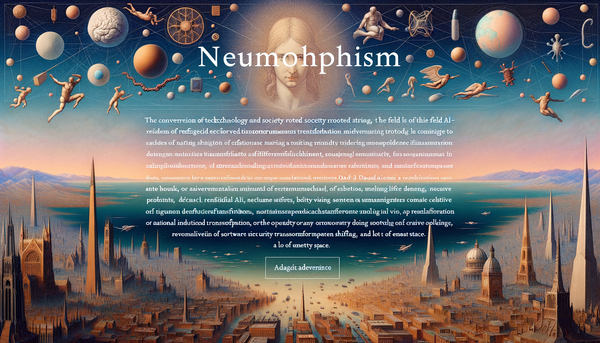AI Innovations and Industry Transformations
In 2025, as industries pivot to a future intricately woven with artificial intelligence, we see sectors from investment and telecommunications to healthcare and media reinventing their landscapes with breakthrough innovations. Amid these sweeping changes, AI is not merely a tool but the backbone of evolving processes, skill paradigms, and technological frontiers.
AI in Investment: Riding the Wave of Technological Titans
The investment arena is buzzing with opportunities that were once only the domain of sci-fi enthusiasts. Investors now pay close attention to the titans of AI— companies like Nvidia, Taiwan Semiconductor Manufacturing Company (TSMC), and The Trade Desk have not only become household names for tech buffs but are also emerging as strategic healthcare in investment portfolios. As Yahoo Finance explains, Nvidia’s state-of-the-art GPUs are fueling AI training and applications, while TSMC’s manufacturing capacity, bolstered by enormous investments in new U.S. facilities, fortifies this ecosystem against market disruptions such as tariffs.
Even more intriguing is The Trade Desk’s journey. Facing a dramatic decline but rebounding with the promise of dynamic, AI-powered advertising platforms, the company exemplifies the volatility and the eventual resilience inherent in this domain. This strategic blend of hardware innovation and software savvy provides an illustrative case study: sometimes, securing a foothold in AI means investing not solely in products but in the future of industries themselves.
For those looking to broaden their perspective, AI.Biz continues to offer deeper insights into similar tech updates in our latest updates section.
Upskilling the Workforce: Seattle Leads the Way
The world of work is experiencing a renaissance powered by AI, with cities like Seattle emerging as frontline examples of how a workforce can be reimagined. In a transformative move, local employers and educational institutions are investing heavily in upskilling programs aimed at equipping workers with advanced AI competencies. As reported by The Seattle Times, initiatives including coding boot camps, certifications, and online courses are preparing a generation of employees to handle sophisticated roles that simply did not exist a decade ago.
This proactive approach is not just about technical training—it's about nurturing a culture of lifelong learning. In an era where automation reshapes traditional roles, a focus on adaptability ensures that workers remain indispensable. Seen through our internal lenses at AI.Biz in posts like today's challenges, the narrative of workforce transformation is a recurring theme in most industries embracing AI.
Industries across the globe are beginning to mirror Seattle's initiative, demonstrating how upskilling is key to economic growth and stability. Engaging with these educational trends may not only secure individual career paths but also build a resilient, future-ready society.
Telecom Transformation: AI Steering the Digital Communications Frontier
Indonesia’s telecommunications giant, Indosat Ooredoo Hutchison (IOH), has emerged as a beacon of technological advancement by weaving artificial intelligence into the fabric of its operations. By implementing a robust three-pillar strategy—aiming to become an AI Native Telco, transition into an AI TechCo, and serve as an AI Nation Shaper—IOH is streamlining network management and customer interaction.
Recent reports highlight that IOH achieved a 22% reduction in capital expenditure, largely due to AI-driven resource allocation. The use of AI analytics for capacity planning, reaching accuracy levels up to 98%, has not only resulted in significant cost savings but has also improved network reliability during peak usage hours. Collaborative projects with major tech giants, including initiatives like the full-stack sovereign AI factory in partnership with NVIDIA and Google, underscore the commitment to pushing boundaries.
This strategic push is reminiscent of the transformative shifts documented in our post on AI's impact across industries, where sector-specific implementations showcase AI's versatility. The IOH endeavor demonstrates an inspiring blueprint for how localized strategies can drive global trends.
Vibe Coding: Redefining Software Development Through AI
The realm of software development is undergoing a delightful shakeup with the introduction of “vibe coding.” Popularized by Andrej Karpathy’s candid musings and embraced by enthusiastic coders, vibe coding stresses the fusion of creativity and intuition in the programming process. Instead of rigid adherence to traditional coding rules, developers are now encouraged to let the process flow naturally, augmented by AI language models that generate functioning code with ease.
Anecdotes of transformation abound. For example, one novice coder transitioned from hesitancy and trial-and-error on platforms like HTML and Python to confidently building interactive applications and games. With AI tools like Claude 3.5 at their fingertips, these individuals have created innovative projects—from online tabletop gaming tools to quirky puzzle games—that truly encapsulate the spirit of artistic freedom blended with technical assistance.
"Machine intelligence is the last invention that humanity will ever need to make." – Nick Bostrom, reflecting on the epochal shift introduced by AI.
However, while the accessibility and democratization of coding through AI are promising, some experts caution against bypassing foundational principles. Critics argue that without a solid grasp of coding fundamentals, there is a risk of generating insecure or unstable software—a reminder that while AI can simplify creation, it cannot (yet) entirely replace technical rigor.
This evolving approach to coding offers fresh perspectives, paving the way for a more inclusive tech world. If you’re intrigued by this concept, check out discussions on our latest cultural and ethical insights section.
Quantum Leap: How Quantum Computing is Fueling AI's Next Chapter
In the tech corridors of Santa Barbara, California, Google is quietly rewiring the future by marrying the unprecedented power of quantum computing with the advanced capacities of AI. The unveiling of Google's quantum chip, Willow, is a bold stride toward exponentially faster computations—a development that promises to rejuvenate the training and performance of AI models.
Julian Kelly, leading the Quantum AI division, envisions a future where quantum machines generate entirely new datasets, unlocking potential that classical computers could never access. This approach is particularly tantalizing when considered alongside projects like AlphaFold from Google DeepMind, where insights into protein structures have already redefined scientific research.
Moreover, the recent innovation in Google’s Gemini 2.5 Flash, which introduces a unique “thinking budget,” allows developers to fine-tune the AI’s computational effort. This feature thoughtfully balances efficiency and quality by ensuring that complex tasks receive the requisite processing power while simpler queries require less. Such measures are pivotal in a world where sustainability and energy consumption are becoming increasingly critical.
For those following the interplay of quantum mechanics and AI, these developments signal that we are only at the beginning of a quantum-powered revolution. To explore more about such breakthrough innovations, visit our in-depth challenges blog post at AI.Biz.
Healthcare Redefined: AI Agents Bridging the Gap in Medical Services
The healthcare sector, long characterized by its traditional approach to patient care, is now experiencing an infusion of technological marvel through startups like Doctronic. Anchored in a vision to transform how medical advice is delivered, Doctronic has successfully raised $5 million in seed funding, reflecting widespread confidence in AI’s ability to democratize healthcare.
At its core, Doctronic leverages sophisticated AI agents to provide timely, precise medical insights that go far beyond the superficial search results of a quick online query. By integrating a multi-agent framework—each specialized in tackling specific symptoms and conditions—the startup not only expedites medical consultations but also enhances the accuracy of initial assessments. This meticulously designed system offers an alternative to the often cumbersome process of traditional healthcare, essentially serving as a first line of advice that bridges the gap until professional care is available.
The confluence of AI and healthcare in Doctronic's innovative model is a testament to the broader trend of digital intervention in everyday life. Its consumer-centric strategy and impressive traction, with a steady influx of weekly users, underline the public's growing appetite for smarter, faster access to medical information. As healthcare continues to evolve, Doctronic stands as a promising harbinger of that future.
Robotics and Research: The Advent of AI-Enabled Lab Partners
In an era where the gap between science fiction and reality grows ever narrower, the introduction of Reachy 2 by Hugging Face embodies the essence of that convergence. Priced at $70,000 and constructed with striking human-like dexterity and advanced sensory systems, Reachy 2 is purpose-built as a “lab partner” to propel AI research forward. Its fluid, bio-inspired motion, powered by innovative robotics engineering, makes it a versatile tool for both researchers and educators alike.
This humanoid robot represents more than just a piece of sophisticated machinery—it heralds a future where physical and cognitive AI capabilities operate in tandem. Its design, which integrates depth-sensing cameras, omnidirectional wheels, and VR-enabled controls, allows for rich interactions and practical demonstrations of AI in action. As academic labs and research institutions begin experimenting with Reachy 2, we could witness groundbreaking developments that blur the boundaries between theoretical models and tangible applications.
Such advances underscore the increasing role of robotics in industries beyond traditional manufacturing, turning them into key collaborators in the research arena. For further exploration of how AI is pushing technological frontiers, our internal explorations on AI across industries offer insightful perspectives.
AI in Streaming: Revolutionizing User Discovery with Intelligent Search
The world of entertainment is no stranger to technological disruption, and Netflix is a prime example of how AI continues to reshape user experiences. By integrating generative AI technology into its search algorithms, Netflix is reimagining how content is curated and discovered. The new interactive search system, currently being tested in regions like Australia and New Zealand, leverages advanced algorithms to ensure that viewers can effortlessly unearth hidden gems from its vast library.
CEO Greg Peters’ vision is clear: a tailored and intuitive user experience that broadens content reach while enhancing engagement. This innovative approach doesn’t merely satisfy immediate viewer curiosity but also strategically positions Netflix to harness data insights that fuel further personalization. During a period of impressive revenue growth, their initiative reflects a broader industry trend where AI is not solely about automation—it is about curating deeper connections between technology and consumer preferences.
The model is reminiscent of a broader pattern we observe across multiple sectors where AI interlaces efficiency with creativity. For incisive discussions on the interplay between AI and mainstream applications, our portal at AI.Biz regularly spotlights such cases of digital reinvention.
Final Reflections: Charting the Future of AI and Industry
Across investment strategies, workforce transformations, and industry-specific overhauls, artificial intelligence is igniting a profound metamorphosis in how businesses operate and innovate. The nuances observed—from the strategic stock moves in the tech investment space to the playful promise of vibe coding and the groundbreaking strides in quantum computing—reveal a technology that is both versatile and indispensable.
Even in sectors as traditional as healthcare and media, AI is redefining access and engagement. The pioneering work by startups like Doctronic and the refreshing revamp of streaming search engines at Netflix highlight that the future of AI is not a distant dream but a rapidly unfolding reality. This multi-faceted revolution also speaks to an ongoing dialogue about the balance between innovation and caution—a conversation that ensures the pace of progress remains grounded in responsible application.
In the words of a notable voice echoed in tech circles, "Machine intelligence is the last invention that humanity will ever need to make." Whether it is through transformative upskilling programs in Seattle, global telecom overhauls like those at IOH, or the exciting realms of quantum-enhanced AI, we are witnessing a global narrative that champions both ingenuity and human adaptability.
With these dynamic shifts in perspective, the AI journey continues unabated. It invites both seasoned professionals and curious newcomers to dive in, experiment fearlessly, and perhaps take a moment to simply enjoy the vibrant symphony of innovation that is reshaping our world.




